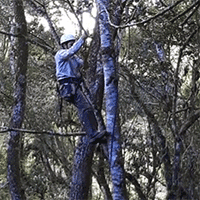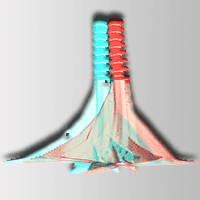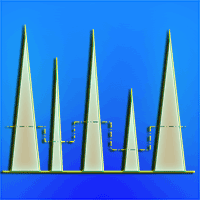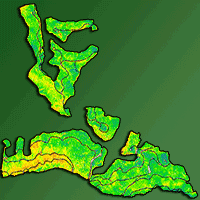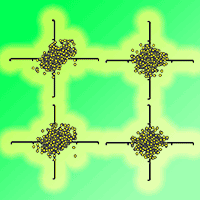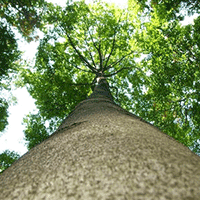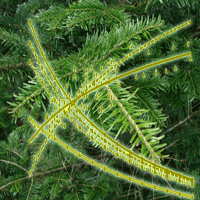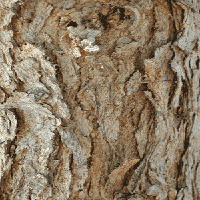
Allometric relationships for predicting the stem volume in a Dalbergia sissoo Roxb. plantation in Bangladesh
iForest - Biogeosciences and Forestry, Volume 3, Issue 6, Pages 153-158 (2010)
doi: https://doi.org/10.3832/ifor0554-003
Published: Nov 15, 2010 - Copyright © 2010 SISEF
Research Articles
Abstract
Allometric relationships for estimating stem volumes of Dalbergia sissoo Roxb. (Sissoo) trees were investigated in monoculture plantations in Bangladesh. The various allometric relationships between stem volume and different dimensions were tested and the coefficient of determination R2 values were used to compare the strength of the relationships. Although the allometric equations were highly significant (P<0.01) there was considerable variation among them as indicated by the R2 values. Our results suggested that tree volume is more correlated with basal area than with simple D (stem diameter at 1.3 m height above the ground). The allometric relationships of stem volume to the tree diameter at 10% of tree height (D0.1) did not improve the allometric strength in comparison with simple D as reported in case of some other tree species. The multiplication of tree height H with D in the allometric equation gives a little improvement in the degree of fitness of the allometric equations. However, for the Sissoo plantations studied the stem dbh alone showed a very strong accuracy of estimation (R2 = 0.997) especially when used as D2. It is concluded that the use of tree height in the allometric equation can be neglected for the species, as far as the present study area is concerned. Therefore, for estimating the stem volume of Sissoo, the use of D2 as an independent variable in the allometric equation with a linear or quadratic equation is recommended. The paper describes details of tree volume allometry, which is important in silviculture and forest management.
Keywords
Allometry, Monoculture plantation, Regression, Rosewood, Sissoo, Stem volume
Authors’ Info
Authors’ address
Department Forest Biometry and Systems Analysis, Institute of Forest Growth and Forest Computer Sciences, TU Dresden, P.O. Box 1117, D-01735 Tharandt (Germany)
Corresponding author
Paper Info
Citation
Khan NI, Faruque O (2010). Allometric relationships for predicting the stem volume in a Dalbergia sissoo Roxb. plantation in Bangladesh. iForest 3: 153-158. - doi: 10.3832/ifor0554-003
Paper history
Received: Mar 04, 2010
Accepted: Oct 01, 2010
First online: Nov 15, 2010
Publication Date: Nov 15, 2010
Publication Time: 1.50 months
Copyright Information
© SISEF - The Italian Society of Silviculture and Forest Ecology 2010
Open Access
This article is distributed under the terms of the Creative Commons Attribution-Non Commercial 4.0 International (https://creativecommons.org/licenses/by-nc/4.0/), which permits unrestricted use, distribution, and reproduction in any medium, provided you give appropriate credit to the original author(s) and the source, provide a link to the Creative Commons license, and indicate if changes were made.
Web Metrics
Breakdown by View Type
Article Usage
Total Article Views: 59789
(from publication date up to now)
Breakdown by View Type
HTML Page Views: 49227
Abstract Page Views: 3627
PDF Downloads: 5387
Citation/Reference Downloads: 32
XML Downloads: 1516
Web Metrics
Days since publication: 5492
Overall contacts: 59789
Avg. contacts per week: 76.21
Citation Metrics
Article Citations
Article citations are based on data periodically collected from the Clarivate Web of Science web site
(last update: Mar 2025)
Total number of cites (since 2010): 11
Average cites per year: 0.69
Publication Metrics
by Dimensions ©
Articles citing this article
List of the papers citing this article based on CrossRef Cited-by.
References
Estimating branch dry weight and leaf area from measurement of branch girth in Eucalyptus. Forest Science 8: 132-141.
Gscholar
Variation in wood density determines spatial patterns in Amazonian forest biomass. Global Change Biology 10: 45-562.
CrossRef | Gscholar
Estimating biomass and biomass change of tropical forests: a primer. FAO Forestry Paper 134, Rome, Italy.
Gscholar
Biomass estimation methods for tropical forests with applications to forest inventory data. Forest Science 35: 881-902.
Gscholar
Introduction to the field sites. In: “International workshop on agroforestry investment, production and marketing”. Dehra Dun (India), 17-26 Sept. 1995. APAN Report no. 20, FAO/APAN.
Gscholar
Allometric relations in hinoki (Chamaecyparis obtusa (Sieb. et Zucc.) Endl.) trees. Bulletin of Nagoya University Forestry 12: 11-29.
Gscholar
Unirrigated canal plantation in the United Provinces. Indian Journal of Forestry 71: 331-335.
Gscholar
The regional variation of aboveground live biomass in old-growth Amazonian forests. Global Change Biology 12: 1107-1138.
CrossRef | Gscholar
Analysis of mangrove stands. Japanese Journal of Ecology 24: 237-246 (in Japanese with English summary).
Gscholar
Methods of estimating forest biomass. In: “Primary productivity of Japanese forests” (Shidei T, Kira T eds). Productivity of terrestrial communites, University of Tokyo Press, Tokyo, pp. 15-36.
Gscholar
A quantitative analysis of plant form-the species model theory. II. Further evidence of the theory and its application in forest ecology. Japanese Journal of Ecology 14: 133-139.
Gscholar
First irrigated plantation of Rajasthan. Indian Journal of Forestry 89: 690-700.
Gscholar
Biomass of mangrove forest and a sedge marsh on Ishigaki island, south Japan. Japanese Journal of Ecology 33: 231-234.
Gscholar
Standing biomass of mangrove forests in southern Thailand. Journal of Japanese Forestry Society 68: 384-388.
Gscholar
A monograph on Dalbergia sissoo Roxb. Indian Council on Forestry Resource and Education, International Books Distributors, Deharadun, India.
Gscholar
The silviculture of Indian trees 1. Oxford University Press, Oxford, United Kingdom.
Gscholar

